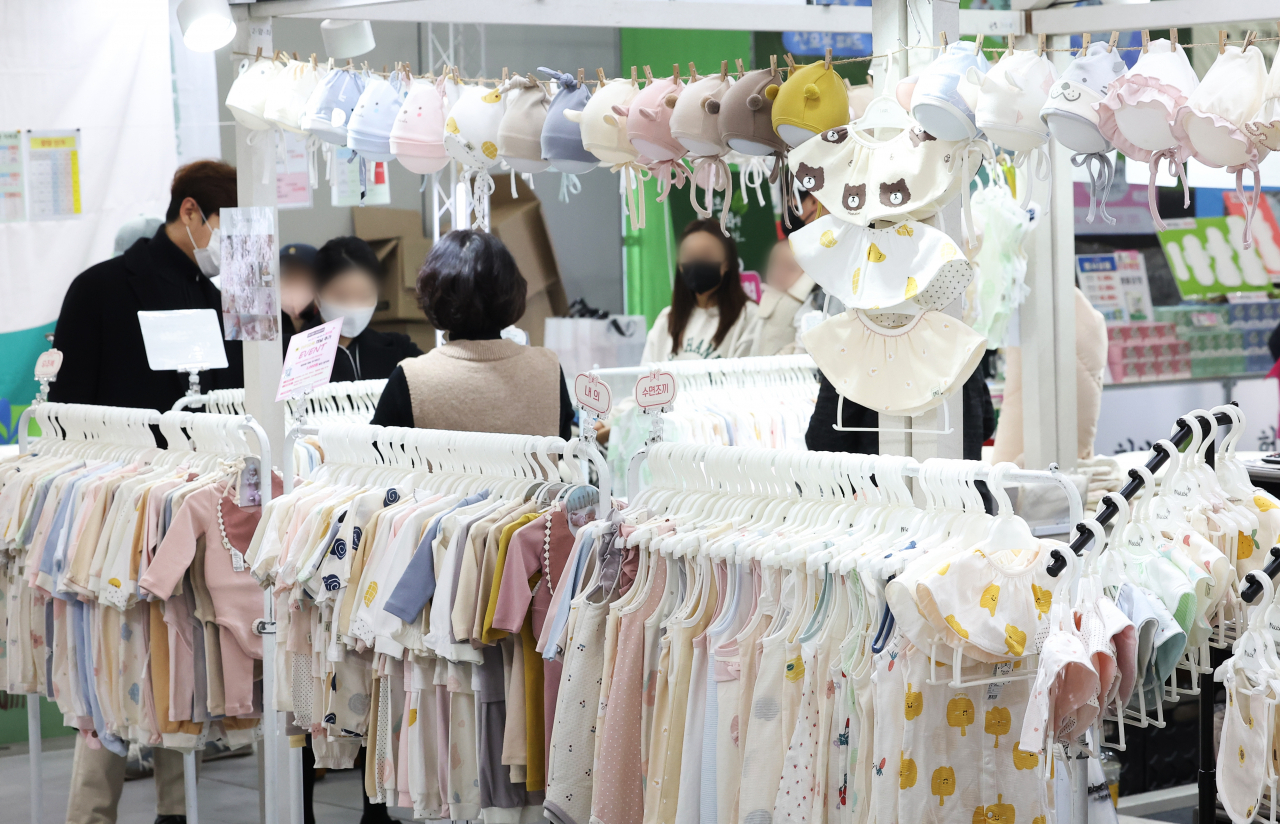 |
Visitors look around a fair of baby products held in Suwon, Gyeonggi Province on Feb. 5. (Yonhap) |
South Korea's total fertility rate hit an all-time low last year, government data showed Wednesday, darkening prospects for one of the world's most aged countries.
In 2022, the country saw 249,000 newborns, down 4.4 percent, or 11,500 less, than that of the year before.
The fertility rate, the average number of children women aged 15-49 have, fell to 0.78, down 0.03 from the 0.81 of the previous year, according to Statistics Korea.
The figure hit an all-time low since the statistics agency began compiling related data in 1970. The country’s fertility rate has remained below 1 for five straight years.
Korea was also the only nation with a fertility rate lower than 1 among member countries of the Organization for Economic Cooperation and Development.
The figure is similar to the projection made by the agency in December 2021, which forecast that the fertility rate would hit 0.77 in 2022. According to the projection, the rate will fall to 0.73 this year and to 0.7 next year.
“Seeing the fertility rate for last year was 0.78, the (downward) trend largely proves to be right,” Lim Young-il, head of Population Census Division at Statistics Korea, said at a press briefing Wednesday.
Compared to a decade earlier, Korea’s fertility rate fell by nearly half. In 2012, 484,600 children were born with the fertility rate standing at 1.3. It was evaluated that Korea had entered an era of ultra-low fertility rate that year.
Compared to Korea's 2022 fertility rate of 0.78, the average total fertility rate of OECD countries was 1.59 as of 2020, according to the organization's latest data.
OECD member countries with high fertility rates were Israel (2.9), Mexico (2.08) and France (1.79). Other nations with relatively low fertility rates were Italy (1.24), Greece (1.28) and Japan (1.33).
Along with the dipping fertility rate, the country's crude birth rate, referring to the number of births per 1,000 people per year, hit a record low of 4.9 last year, down from 5.1 a year ago.
By region, Seoul showed the lowest fertility rate, with 0.59, followed by Busan at 0.72.
The average age for women giving birth was 33.5 in 2022, slightly up from 33.4 last year, higher than the OECD average of 29.3 in 2020. For firstborns, the average age of delivery was 33, for second children 34.2 and third children 35.6.
The ratio of baby boys to every 100 newborn girls was 104.7 last year, down 0.4 from the previous year.
In the past, the ratio of boys to girls among newborns remained well above parity due to Korea's social preference for male children, but the figure has been on a steady decline amid changing social norms.
The agency added the figure is in the normal range from 103 to 107 boys per 100 girls for all groups from firstborns to third children. Without intervention, newborns are slightly more likely to be boys than girls, with a ratio of about 105.
On the other hand, deaths in Korea rose, standing at 372,800 for 2020, up 55,100 from the previous year. The figure hit all-time high since first recorded in 1970. The agency explained the toll was affected by the COVID-19 pandemic and aging population.
The crude death rate was 7.3 per 1,000 people, up 1.1 from the year before. The figure has been on the rise since 2010.
Like previous years, deaths outpaced childbirths by 123,800. Since 2020, Korea has been seeing more deaths and fewer childbirths, leading to the concerns related to population decline.
The pace of depopulation has been accelerating, with the gap widening from 32,600 in 2020, and 57,100 in 2021.






![[Today’s K-pop] Blackpink’s Jennie, Lisa invited to Coachella as solo acts](http://res.heraldm.com/phpwas/restmb_idxmake.php?idx=644&simg=/content/image/2024/11/21/20241121050099_0.jpg)
